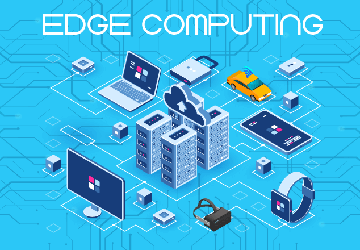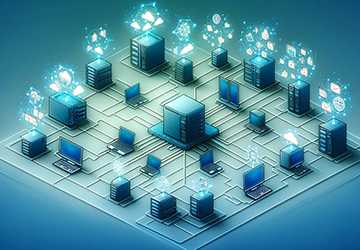Edge Computing Enabling the Next Generation of Internet of Things Innovations
The digital landscape is changing rapidly, with the Internet of Things (IoT) and edge computing leading the revolution. Edge computing in IoT is a groundbreaking advancement that offers unprecedented benefits and is shaping the future of technology. This article explores the benefits of edge computing, its applications in IoT, and the future of edge computing technology.

Edge Computing Basics
What is Edge Computing?
Edge computing embodies a decentralised computing paradigm in which computation occurs close to the data source rather than in a centralised cloud environment. This proximity to the data source increases the efficiency and speed of data processing, making it a perfect fit for IoT applications.
The Role of IoT in Modern Technology
The Internet of Things (IoT) refers to networked devices communicating and exchanging data. Edge computing in IoT enables these devices to process data on-site, reducing latency and improving real-time decision-making.
Benefits of Edge Computing
Improved Performance
One of the main benefits of edge computing is improved performance. The time interval required for data to be transmitted to and from a central server is significantly reduced by processing data at the edge close to the data source.
Lower Latency
Edge computing significantly reduces latency, which is critical for applications that require instant responses, such as autonomous vehicles and industrial automation.
Improved Security
Edge computing in IoT allows sensitive data to be processed locally, reducing the risk of data leakage during transmission. This local processing provides an additional layer of security, which is particularly beneficial for critical applications.
Cost-Effectiveness
Another prominent advantage of edge computing is cost-effectiveness. By reducing the amount of data that must be transmitted to the cloud, companies can save on bandwidth fees and reduce the load on central servers.
Edge Computing in IoT Applications
Smart Cities
In smart cities, edge computing in IoT is essential for efficiently managing resources. For example, intelligent transportation systems can process data locally to optimise traffic flow and reduce congestion.
Healthcare
In healthcare, IoT edge computing is revolutionising patient care. Wearable devices can monitor patients' vital signs in real-time and process data locally, sending alerts to healthcare providers as soon as anomalies occur.
Industrial Automation
Edge computing greatly benefits Industrial IoT applications. By processing data at the edge, factories can monitor and control machines in real-time, improving efficiency and minimising downtime.
Retail
In retail, edge computing in IoT improves customer experience through personalised services. For example, intelligent shelves can monitor inventory in real time and process data to ensure timely replenishment.
The Future of Edge Computing Technology
Increasing Acceptance
The future of edge computing technology looks promising, with increasing adoption rates across industries. As more devices are connected to the internet, the demand for edge computing solutions will continue to grow.
Advances in AI and Machine Learning
Integrating artificial intelligence (AI) and machine learning (ML) with IoT edge computing will further expand its capabilities. These technologies can analyse data locally, making predictive analytics and real-time decision-making more efficient.
Improved Connectivity
The future of edge computing technology will see improved connectivity with the advent of 5G networks. This high-speed connectivity enables faster data processing and lower latency, making edge computing more efficient.
Sustainability
Sustainability is increasingly becoming an essential aspect of technological development. Edge computing promotes sustainable development by reducing energy consumption associated with data transfer between central servers.
Challenges and Solutions
Data Management
Managing large-scale data at the edge can be challenging. However, advances in storage solutions and data management technologies are addressing these challenges and making edge computing in IoT more feasible.
Standardisation
The need for greater standardisation of edge computing technology raises a question. Developing industry-wide standards is essential for seamless integration and interoperability of edge computing solutions.
Security Issues
While edge computing improves security through local data processing, it also brings new security challenges. Strong security measures at the edge are essential to protect against potential threats.
Innovations in Edge Computing
Distributed Intelligence
The convergence of edge computing in IoT has given rise to distributed intelligence, where data processing functions are distributed across different nodes. This enables IoT devices to make decisions autonomously, improving operational efficiency and speed.

Data Sovereignty
One of the new benefits of edge computing is the promotion of data sovereignty. Organisations can more effectively comply with regional data protection laws by localising data processing, ensuring that sensitive information remains within specific geographic boundaries.
Fault Tolerance
Edge computing in IoT enhances fault tolerance by decentralising data processing. This paradigm ensures that even if one node fails, other nodes can maintain operations, providing resilient and uninterrupted service.
New Trends in Edge Computing Technology
Federated Learning
Federated learning is an innovative approach where edge computing in IoT devices jointly trains machine learning models while keeping data localised. The technology improves privacy and reduces data transmission costs, making it ideal for confidential applications.
Edge AI Collaboration
Combining edge computing and artificial intelligence (AI) opens up new possibilities. By embedding AI capabilities at the edge, devices can perform complex analyses and make autonomous decisions without relying on centralised cloud resources.
Micro Data Centers
Micro data centres are an emerging trend in the future of edge computing technology. These micro data centres close to the source provide massive computing power and storage capabilities, ensuring low latency and high performance.
Policy and Regulatory Considerations
Data Management
An effective data management strategy will be critical in the era of edge computing in the IoT. Companies must adopt a solid framework to manage data ownership, privacy, and compliance and ensure data is used ethically and responsibly.
Security Standards
Strict security standards must be established and maintained to protect edge computing technology; this includes implementing encryption, access controls, and regular audits to protect against cyber threats and ensure data integrity.
Investment and Financing
Strategic investment and funding will shape the future of edge computing technology. Governments and private companies must commit resources to research and development, encourage innovation, and accelerate the adoption of edge computing solutions.
Conclusion
In summary, edge computing offers numerous benefits, and its integration with the Internet of Things is transforming various industries. The future of edge computing technology is bright, and advances in artificial intelligence, machine learning, and connectivity are expected to unlock even more significant potential. However, it is critical to address its associated challenges to realise the benefits of edge computing.